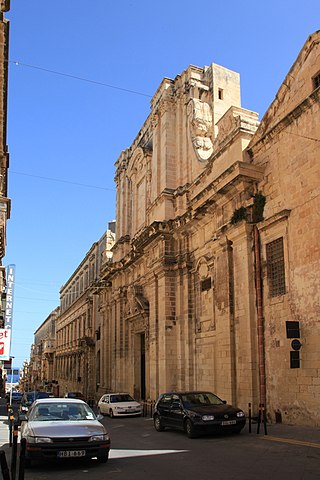
Limonium is a genus of about 600 flowering plant species. Members are also known as sea-lavender, statice, caspia or marsh-rosemary. Despite their common names, species are not related to the lavenders or to rosemary. They are instead in Plumbaginaceae, the plumbago or leadwort family. The generic name is from the Latin līmōnion, used by Pliny for a wild plant and is ultimately derived from the Ancient Greek leimon.

The Church of the Circumcision of Our Lord, also known as the Church of the Jesuits or the Church of the University, is one of the oldest and largest churches in Valletta, Malta. It was originally built between 1593 and 1609 by the Jesuit order, and it is located adjacent to the Old University Building, which originally housed a Jesuit college known as the Collegium Melitense. The church was rebuilt in the Baroque style by Francesco Buonamici after suffering extensive damage in an explosion in 1634. The church remained in use after the Jesuits were expelled from Malta in 1768, and it is also used for Masters and Doctoral graduation ceremonies of the University of Malta, the successor to the Collegium.

Helichrysum panormitanum subsp. melitense, synonym Helichrysum melitense, is a subspecies of flowering plant in the family Asteraceae and is endemic to Malta, specifically to the island of Gozo. It is known as the Maltese everlasting. It can be found in Dwejra, and in cliffs in Gozo near Fungus Rock. Its natural habitats are Mediterranean-type shrubby vegetation on Coastal garigue and vertical sheer cliffs. Recently, it was recorded in new locations on the island of Gozo. This plant is on the decline in the wild, and it is threatened by habitat loss. It is very easy to cultivate, and it is gaining ornamental popularity amongst the locals.
Agdistis paralia is a moth in the family Pterophoridae. It is known from Spain, France, Italy, Malta, Greece, Israel, Turkmenistan, Tunisia, Algeria and Morocco. It has also been recorded from China (Gansu).

Thomas Cauchi was a minor Maltese philosopher who specialised in law.
Saverius Pace was a minor Maltese philosopher who specialised in physics.
George Sagnani was a minor Maltese philosopher who specialized mainly in ethics and morals.

The Collegium Melitense was a Jesuit college in Valletta, Hospitaller Malta, which existed between 1592 and 1769. Lectures at the educational institution began in 1593, and it moved to a purpose-built building adjacent to a Jesuit church in 1597. The 17th century saw an expansion of its curriculum and an increase in the number of students in the college, and in 1727 it was recognised as a university and subsequently it also became known as the Academia Parthenia. After the Jesuits were suppressed from Malta, the college was reorganised into the Pubblica Università di Studi Generali, which was established on 22 November 1769. The latter is now known as the University of Malta.
Salvatore Brullo is professor at University of Catania since 1980 teaching Systematic Botany, he obtained a degree in natural science on July 1970. For six years he was Director of the Department of Botany, at the University of Catania.

Bengħisa Tower, originally known as Torre di Benissa and also referred to as the Red Tower, was a small watchtower in Bengħisa, within the limits of Birżebbuġa, Malta. It was built in 1659 as the seventh of the De Redin towers, on or near the site of a medieval watch post. An entrenchment was built around the tower in 1761, and it was armed with 10 guns. The tower was demolished by the British to clear the line of fire of the nearby Fort Benghisa in 1915.

The Slaves' Prison officially known as the Grand Prison and colloquially as the bagnio, was a prison in Valletta, Malta. It was established in the late 16th century, and remained in use as a prison throughout the 17th and 18th centuries. It was subsequently used as a naval hospital, a school and an examination hall. It was bombed in World War II, and the ruins were demolished to make way for a block of flats.

Ġnien is-Sultan, also known as the Giardino della Marina, the Grand Master's Garden or Lascaris Garden, was a garden in Valletta, Malta. It was established in the 17th century by Giovanni Paolo Lascaris, and included a summer residence for the Grand Master. The garden included several Baroque elements designed by Francesco Buonamici.

Ħalfa Rock(Maltese: Il-Ġebla tal-Ħalfaor Il-Blata tal-Ħalfa''') is a deserted small islet and limestone rock on the south-east coast of the island of Gozo in the Maltese archipelago. The islet is typified by a small maritime labiate garrigue environment, with germander and prasium shrubs, with the occurrence of the endemic Maltese Pyramidal Orchid as well as endemic coastal communities based on the Maltese Sea-Lavender and the sub-endemic Maltese Crosswort.

The Old University Building, also known as the Valletta Campus, is the original campus of the University of Malta, located adjacent to the Church of the Jesuits in Valletta, Malta. Construction of the building began in 1595, and it originally housed a Jesuit college known as the Collegium Melitense Societatis Jesu. The building had to be repaired after being damaged in an explosion in 1634 and an earthquake in 1693.
Allium melitense is a species of wild leek endemic to the Maltese archipelago. The species was first described as a variety of Allium ampeloprasum by Stefano Sommier and Alfredo Caruana Gatto in their Maltese flora published in 1915, while emphasizing its observable differences with A. ampeloprasum and the need for further study. The taxon was then elevated to species by Raffaele Ciferri and Valerio Giacomini, and again by Mifsud & Mifsud in 2018.
Limonium zeraphae is a species of plants in the family Plumbaginaceae (leadworts). It is endemic to Malta.
Hypericum australe is a species of plant in the family Hypericaceae. Individuals can grow to 24 cm tall.

Limonium virgatum is a species of plants in the family Plumbaginaceae (leadworts). Individuals can grow to 17 cm tall.










